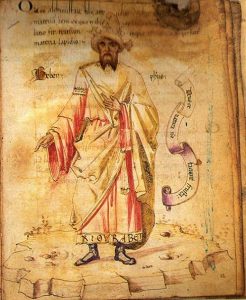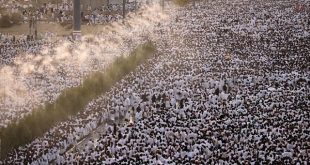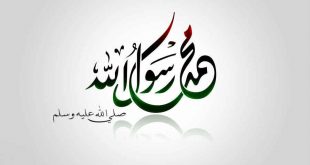Until recently, the mainstream history of scientific ideas has failed to acknowledge numerous Islamic scientists and their great efforts and achievements throughout the centuries. This short article seeks to contribute in redressing this injustice by highlighting Muslim contributions and attitudes towards the progress of chemistry.
Salim T S Al-Hassani* and Mohammed Abattouy**
Before addressing the main subject of this article, an important remark needs to be made. It concerns the etymology and the root of the word “alchemy”. The use of this word is a representative big corruption of science on the part of scholars, including Muslim-Arabic speaking scholars. The source of the corruption is two fold: linguistic and anti Muslim bias.
As far as the linguistic source goes, alchemy is just a bastard traduction of the Arabic word kimmiyâ (meaning quantity, and from which was derived al-kîmiya used to designate the science of chemistry,) preceded by the article “al” (which means the article “the”), and which the Arabs always use (like the French and others for that matter). Only Barron Carra de Vaux had had the presence of mind to pointing to this, however briefly [1]. The article “al” does not exist with respect to other sciences because as an instance Al-Tib (Arabic for medicine) is not the word we call medicine today, or Al-Riyadhiyat the word we use for mathematics. Somehow al-kîmia should be translated literally as The Chemistry and not Alchemy; in French “la chimie” and not l’alchimie. The fact that only Westerners translated or dealt with the subject, followed by rather shy Muslim scholars, the bastardised word of alchemy has remained, and has become the norm.
 |
|
Figure 2: Chemical apparatus depicted in two pages of the Alchemiae Gebri Arabis philosophi solertissimi libri (Bern, 1545). (Source). |
The second reason, due to anti Muslim bias, explains why alchemy is still used instead of chemistry. The object of those with anti Muslim bias is to use scholarly methods, techniques and arguments, the open and the subtle. Here, the aim of these scholars is to avoid by all means making scientific and experimental chemistry a Muslim science. Chemistry is fundamentally based on experimentation with substances, turning one substance or matter into another by means of experimentation and laboratory work. This has been mainly the work of Muslims, and Muslims alone. Whilst the Greeks championed speculation and metaphysical analysis about chemical processes, the Muslims relied on experimentation. Such an approach was championed very early in particular by Al-Razi, who may be considered consequently the father of modern chemistry. And it is the Muslims who laid the foundations of this science as it will be shown in the following. Rather than admit that, or because of that, the scholars not familiar with Arabic scientific literature or holding prejudices in conceiving the progress of scientific ideas in history continue to use the word alchemy to refer to the Arabic chemical tradition, whilst it should be Chemistry. The consequence of both approaches leds, somehow, to lock the Muslim science into the corner of alchemy, which is mostly connected with cranks and frauds of all sorts and occult practices. In this context, only Western modern scientists such as Lavoisier, Berthelot and other scholars deserve to be called the chemists.
Thus, it is hoped that Muslims, first, honest scholars, second, and then, those hostile to Islam, maybe, should start using the real word: Chemistry in connection with the large corpus produced within the scientific tradition of Islam on chemical processes, practices and chemical industry.
Greek alchemy and Islamic chemistry
Whilst relying on the Greek works to acquire their early notions in this subject, Muslim scientists soon realised the shortcomings of the Greek heritage in the field of chemistry. Indeed, although the Greek contribution to science served as the foundation of so much to build upon, its major weakness for instance was the Greek’s reliance on abstract speculation to deal with chemical phenomena. This exercise was stimulating intellectually and to philosophical argumentation, but it hardly led to a quantitative study of chemical transformations. Thus, in the field of chemistry, soon after coming across the Greek output, the scholars of the Islamic lands decided to build a new and experimental science. In doing so, some of them continued using the old terminology and pursued the ancient aims, such as the stone of wisdom which converts base metals into gold and the elixir of life that permits eternal health and youthfulness [2].’
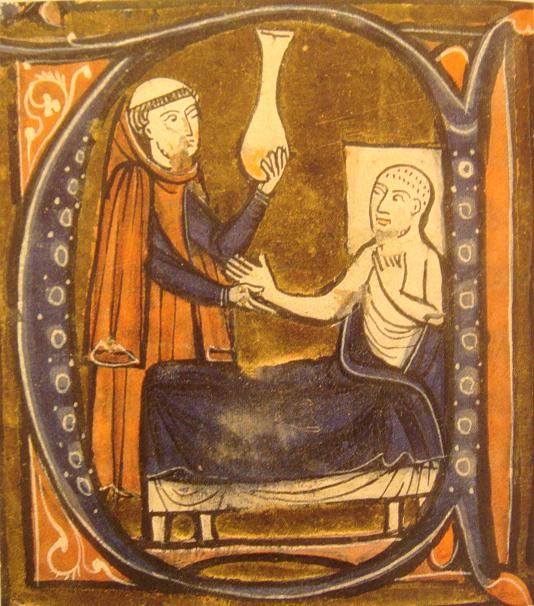 |
|
Figure 4: European depiction of Al-Razi in the Latin version of one of his treatises translated by Gerard of Cremona in between 1250-60. (Image in the public domain). |
To say that there were no Muslim cranks who used chemistry and experimentation to come out with rather crooked, fanciful ideas and results is wrong. Ibn Sina and Ibn Khaldun, both, the rigorous scientists they were, hit, and hard at them. This rejection of doubtful practices, in fact, pursues the early Muslim tradition of rejecting anything that was doubtful in terms of hadiths, and always making sure facts were backed by evidence. Hence both Ibn Sina and Ibn Khaldun attacked the experimentalists who, for instance, sought to turn ordinary metals into precious ones, gold in particular. Ibn Sina, for instance, in The Book of Minerals, denounces the artisans who dye metals in order to give them the outside resemblance of silver and gold. He asserts that fabrication of silver and gold from other metals is “practically impossible and unsustainable from a scientific and philosophical point of view” [3]. Ibn Khaldun, for his part, denounces the frauds of those who apply on top of silver jewellery a thin layer of gold, and make other manipulations of metals. To Ibn Khaldun, the divine wisdom wanted gold and silver to be rare metals to guarantee profits and wealth. Their disproportionate growth would make transactions useless and would `run contrary to divine wisdom [4].’
In the little known, easily readable and succinct book The Civilisation of Islam [5], Jean Mathe summarises well the achievements of Muslim chemists [6]. They discovered alcohol, nitric and sulphuric acids, silver nitrate and potassium. They also determined the weight of many bodies and mastered the technique of sublimation, crystallization and distillation. Muslim chemistry also took many industrial uses, including tinctures and their applications in tanning and textiles; distillation of plants and of flowers, the making of perfumes and therapeutic pharmacy. The works of one amongst them, Jabir ibn Hayyan, which Mathe says reaches 2000 (obviously an over-estimated figure, related to some of the controversies regarding the persona of Jabir) were the bible of European chemists until Lavoisier in the 18th century [7].’
Although scientists such as al-Kindi, especially in his criticism of Greek’s `chemistry,’ and Ibn Sina’s, in hisKitab al-shifa (the book of healing), devote some interest to the subject, and although there were tens of other Muslims who were involved in the science, there were primarily three Muslim chemists, truly masters of their science. These were in the chronology of their lives: Jabir, Al-Razi and al-Majriti.
 |
| Figure 5: Arabic manuscript held in the British Library showing the distillation process in a treatise of chemistry. © The British Library, London. |
Jabir ibn Hayyan
So much controversy surrounds the figure of Jabir ibn Hayyan (722-815). This controversy is well summarised by Dunlop [8]. It mainly evolves around the issue of whether Jabir and the Latin Geber are one and the same scholar. Surely, Geber was the Latin counterpart of Jabir. However, Dunlop considers that the 3000 thousand or so works attributed to Jabir by many, especially some Muslim scholars, are an exaggeration. It is very likely that someone other than him must have written a big part of such a large corpus, and in view of the rather dubious, even dangerous connections then between the so called science of alchemy and the mystic and even occult practices, the person(s) might have preferred to take some prudent steps, using the name of Jabir to cover themselves with his fame and authority. Moreover, that great encyclopaedia of Muslim scholarship up to the 10th century, al-Fihrist by Ibn al-Nadim had its own doubts [9]. And al-Fihrist’s record is absolutely impeccable. Still, even if Jabir is the author of only some hundreds of such treatises, it remains undoubtful that achievements would be considerable. Al-Faruqis [10] offer a very good account of some of such achievements. Some of Jabir’s writings include Al Khawass al-kabir (the Great Book of Chemical properties), al-Mawazin (Weights and measures), Al-Mizaj (Chemical combination), and Al-Asbagh (Dyes). On top of that, he built a precise scale which weighed items 6, 480 times smaller than the ratl(approximately 0,5 kg). Before John Dalton by ten centuries, he defined chemical combinations as a union of the elements together, in too small particles for the naked eye to see, without loss of character. In addition, he invented a kind of paper that resisted fire and an ink that could be read at night. Jabir’s other achievements, gathered from various sources [11], led him to perfect chemical processes such as sublimation, liquefaction, purification, amalgamation, oxidation, crystallization, distillation, evaporation, and filtration, which are described in detail. He also identified many new products, including alkalines, acids, salts, paints and greases. He prepared sulphuric acid, nitro-hydrochloric acid (used to dissolve some metals), caustic soda and a multitude of salts such as sulphates, nitrates and potassium and sodium carbonates. Jabir’s works with metals and salts subsequently helped develop foundry techniques and glazing processes for tiles and other ceramics [12]. However, instead of focusing on his purely scientific contribution to chemistry, many non Muslim scholars dealing with the “alchemy” literature [13], prefer to dwell on the rather tedious, obscure, and un-scientific aspects of his work (or that of the other Geber) which involves celestial influences, mystical uses of figures and symbols, and other fanciful and folkloric matters of Greek and ancient origins (which were the very causes for Ibn Sina’s and Ibn Khaldun’s attacks on certain aspects of this science,) and which contribute to attach to the Muslims un-scientific practices.
Al-Razi the experimantal chemist
Someone these scholars do not refer to for very long is Al-Razi. He was a pure rationalist, no nonsense scientist, who only believed in experimentation and concrete evidence, and never refrained from demolishing all previous speculative and erroneous conclusions, and he did so in every science he touched upon. Al-Razi was born in Rayy in Iran (250-318 H/864-932). Before he left chemistry for medicine, where he became one of the leading authorities, and occupied eminent functions in Baghdad as physician, he was also the founding father of truly modern chemistry. Al-Razi eliminated the symbolic, occult aspects that plagued the so called alchemy, and set up the firm foundations of modern chemistry. He, most of all, set up the laboratory in the modern sense, designing, describing and using more than twenty instruments. Both Anawati and Hill provide a good account of Al-Razi’s elaborate laboratory [14], the precursor of the modern laboratory, and of which many parts are still in use today (although Hill mentions that, Anawati, like many others, chooses to ignore this fact, however important it is) [15]. This crucial contribution to science had amongst other impacts the development of modern pharmacy. Hence, Abu al-Mansur al-Muwaffaq mentions for the first time some chemical facts to distinguish certain medicines [16].
Al-Razi himself was interested in the medical uses of chemical compounds [17]. In his work Secret of Secrets, he made the very useful classification of natural substances, dividing them into earthly, vegetable and animal substances, to which he also added a number of artificially obtained ones such as lead oxide, caustic soda, and various alloys. He went further in the cataloguing and description of his experiments, describing first the materials he used, then the apparatus, and methods and conditions of his experiments [18]. In the Secret of Secrets, he describes in great detail such chemical processes which he performed, and which have their modern equivalent form of distillation, calcination, crystallisation etc [19].
 |
|
Figure 6: Cover of Journal of Chemical Education, September 1995, where H.S. El Khadem published an article on an ancient alchemy lost text reproduced in the Keys of Wisdom by Al-Tughra’i (12th century) [20]. |
The last Muslim chemist to deserve mention here is the Spanish Muslim court scientist al-Majriti (from Madrid) (950-1007). He was particularly noted for his work Rutbat Al-Hakim (The Rank of the Wise), which amongst other things gives formulae and instructions for purification of precious metals. It was collected and put together in the year 1009, two years after his death. In this work, Al-Majriti was also the first to prove the principle of conservation of mass, credited eight centuries later to the French Lavoisier [21].
Of course Muslim chemistry, like other sciences was heavily translated into Latin, and also into local languages, which explains its spread to Europe. Many of the manuscripts translated have anonymous authors, though. Robert of Chester, a 12th century scholar, translated Liber de compositione alchemise. At about the same time, Hugh of Santalla made the earliest Latin translation of lawh azzabarjad (the Emerald table). It is, as per usual, the Italian, Gerard of Cremona, who made the more valuable translations. Amongst others, he translated Al-Razi’s study and classification of salts and alums (sulphates) and the related operations in De aluminibus et salibus, whose Arabic original is preserved [22]. Through its various versions, this work had a decisive influence on subsequent operations in the West, more generally on mineralogy [23]. Still, back to those earlier stages, Alfred of Sareshel translated the part of Ibn Sina’s Kitab al-Shiffa (the Book of Healing) that deals with chemistry. It is, however, in fairly recent times that Muslim chemistry received the greater attention from more Western scholars, starting with Berthelot in the late 19th century, followed by Holmyard, Kraus, and above all Ruska, who give the best and most comprehensive account of Muslim chemistry, much of which unfortunately is inaccessible to non German speakers [24].
Chemistry at the service of pharmacology
In connection with chemistry, a large interest was devoted to pharmacology, which deserves to be fully and thoroughly addressed on its own merits, and to much deserved greater lengths. In recent studies, this subject was examined in the context of Arabic chemistry. It was with this intermediary that several works of Muslim scholars were published and analyzed, such as al-Kindi’s and al-Zahrawi’s chemical investigation aiming at the creation of drugs [25].
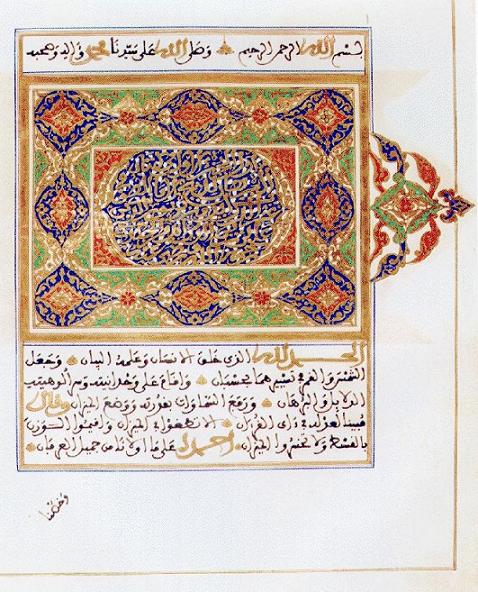 |
|
Figure 7: An illuminated opening from the alchemical treatise The Proof Regarding Secrets of the Science of the Balance (Kitab al-Burhan fi asrar ‘ilm al-mizan) by ‘Izz al-Din Aydamir al-Jildaki (d. 1342/743 H). Undated copy made in Morocco in the late 19th century. National Library of Medicine, Bethesda, MA, MS A7, part 1, fols. 1b-2a. © NLM. (Source). |
The Muslims used in many ways the same methods, means and techniques in both chemistry and pharmacology to produce drugs. Through their experimental methods, they prepared products they used for healing including camphor, alum, ambergris etc. Under Islam, spread the profession of pharmacist, the first shops were opened in the early 9th century in Baghdad. Those shops had to abide by strict rules, regularly visited by a Muhtasib (inspector or market inspector) who applied corporal punishment on pharmacists who adulterated drugs.
Muslim pharmacists were the first to write regular pharmacopoeia, i.e. the cataloguing and the listing of drugs. The technical term used by Muslims was Aqrabadin, a word of Greek origin meaning list or register. According to Levey, the Muslims were excellent organisers of knowledge, and so their pharmacological texts were directed carefully along the many directions which were either promising or useful to the apothecary and medical practitioner. These treatises as a result generally are more or less within well delineated groups. Some of the major types of Muslim pharmacological literature are given by Levey as follows [26]:
1) Medical formularies which include many kinds of compound drugs, pills, pastilles, powders, syrups, oils, lotions, dentifrices, etc.
2) Books on poisons.
3) Synonymatic: treatises in which are found lists of simples usually in alphabetical order to help the reader to identify the drug in other languages.
4) Tabular, synoptic texts, whereby long texts are turned into tabular work for quick usage, and abstracts made of some treatises for the same purpose.
5) Lists of materia medica which include therapeutic considerations and opinions of various writers on the subject, preparations of the drugs and descriptions.
6) Substitute drugs in case one drug for whatever reason was not available, a substitute was provided.
7) Works on medical specialities available either as separate treatises or as sections of large encyclopaedias of medicine.
 |
|
Figure 8: Pharmacist preparing drugs. From a MS of the Arabic translation of Dioscorides’ Materia Medica. (Source). |
There is a large collection of works on the subject legated by Muslim scholars. Sabur Ibn Sahl (d 869) was the first physician to initiate pharmacopoeia, describing a large variety of drugs and remedies to ailments. In the 10th century, Abu Mansur Muwaffaq of Herat wrote The foundations of the true properties of Remedies, where he described 585 drugs [27]. Al-Biruni (d. 1051) wrote one of the most valuable Islamic works on pharmacology entitled Kitab al-Saydanah (The Book of Drugs), where he gave detailed knowledge of the properties of drugs and outlined the role of pharmacy and the functions and duties of the pharmacist. Ibn Sina, too, described no less than 700 preparations, their properties, mode of action and their indications. He devoted in fact a whole volume to simple drugs in his Canon [28]. It would seem, however, that it is the works by Massawayh al-Maridini of Baghdad and Cairo, and Ibn al-Wafid of Spain, that had the largest impact. Both were printed in Latin more than fifty times, appearing as De Medicinis universalibus et particularibus by Mesue the younger, and the Medicamentis simplicibus by Abenguefit [29]. Peter of Abano (1250-1316) translated and added a supplement to the work of al-Maridini under the title De Veneris, thus making the work of al-Maridini the standard reference work in the West for the next centuries [30]. Another later work to demonstrate the heavy dependence on Muslim pharmacology is by Jacques Sylvius (1487-1555) [31].
Concluding Remarks
In the following concluding remarks we summarise the salient points focused upon in the article. Alchemy and chemistry in Islam refer to the study of both traditional alchemy and early practical chemistry by Muslim scientists. The modern word alchemy itself was derived from the Arabic word al-kimia and it should be properly be applied to design chemistry in the modern sense.
The study of alchemy and chemistry often overlapped in the early Islamic world, but later there were disputes between the traditional alchemists and the practical chemists who discredited alchemy. Muslim chemists were the first to employ the experimental scientific method (as practised in modern chemistry). Chemists such as Jabir ibn Hayyan (Latinized as Geber) and al-Razi (Latinized as Rhazes) contributed key chemical discoveries, including: invention of the distillation apparatus (such as the alembic, still, and retort) which were able to fully purify chemical substances; creation of the muriatic (hydrochloric), sulfuric, nitric and acetic acids; use of soda and potash; invention of procedures to produce distilled water and purified distilled alcohol; applying chemical transformation in the industry of perfumery; the discovery that aqua regia, a mixture of nitric and hydrochloric acids, could dissolve the noblest metal.
Besides these outstanding inventions, many chemical substances and apparatus that shaped the history of chemical processes are of Islamic origin. The words elixir, alembic and alcohol are of Arabic origin. From the Arabic names of al-natrun and al-qaliy, Latinized into Natrium and Kalium, come the modern symbols for sodium and potassium.
An early experimental scientific method for chemistry began emerging among early Muslim chemists. Jabir Ibn Hayyan clearly recognized and proclaimed the importance of experimentation. He said in substance that the first essential in chemistry is that one should perform practical work and conduct experiments, for he who performs not practical work nor makes experiments will never attain the least degree of mastery.
Muhammed Al-Razi was the first in his Al-Shukuk ‘ala Jalinus (Doubts about Galen), was the first to prove both Aristotle’s theory of classical elements and Galen’s theory of humorism wrong using an experimental method. He carried out an experiment which would upset these theories by inserting a liquid with a different temperature into a body resulting in an increase or decrease of bodily heat, which resembled the temperature of that particular fluid. Al-Razi noted particularly that a warm drink would heat up the body to a degree much higher than its own natural temperature, thus the drink would trigger a response from the body, rather than transferring only its own warmth or coldness to it. Al-Razi’s chemical experiments further suggested other qualities of matter, such as “oiliness” and “sulfurousness”, or inflammability and salinity, which were not readily explained by the traditional fire, water, earth and air division of elements. Al-Razi was also the first to distill petroleum, to invent kerosene and kerosene lamps, to invent soap bars and modern recipes for soap, to produce antiseptics, and to invent numerous chemical processes such as sublimation.
From the 12th century CE, the writings of chemical works of Jabir, al-Kindi, al-Razi and others became widely known in Europe during the Arabic-Latin translation movement and later through the Latin writings of a mysterious author known in the literature as “Pseudo-Geber”, an anonymous alchemist born in 14th century Spain, who translated more of Jabir’s books into Latin and wrote some of his own books under the pen name of “Geber”.
Acknowledgements
The authors would like to acknowledge the assistance and contribution of the following colleagues in the production and providing documentation for this article: Ms Kathy Mathews, Dr Salah Zaimeche, Dr Salim Ayduz and the staff of Joules and John Rylands Libraries at Manchester University.
Bibliography and further reading
Al-Hassan, A. Y.: online articles at History of Science and Technology in Islam:
- A Critical Reassessment of the Geber Problem: Part One: The Emergence of the Geber Problem: Berthelot’s Assumptions; Part Two: Jabir (Geber)’s Standing in the Latin West And the Translator of the Liber fornacum;Part Three: Berthelot’s Motives in Choosing the Wrong Arabic Alchemical Treatises and the Extant Arabic Works of Jabir on Theoretical and Practical Alchemy and Chemistry.
- Eighth century treatise on glass: Kitab al-Durra al-Maknuna (The Book of the Hidden Pearl of Jabir ibn Hayyan (c. 721–c. 815) On Coloured Glass, On Lustre, On Gemstones And Pearls: Part 1: The Manufacture of Coloured Glass; Part 2: Lustre Glass; Part 3: The Colouring Of Gemstones, The Purifying and Making of Pearls and Other Useful Recipes; Part 4: Assessment of Kitab al-Durra al-Maknuna.
- Al-Hassan, Ahmad Yusuf (1987). “Chemical Technology in Arabic Military Treatises. A Review of the Sources”. In: From Deferent to Equant. Edited by D.A. King and G. Saliba. New York: New York Academy of Science, pp. 153-166.
- Anawati, Georges (1996). “Arabic Alchemy”. In: Encyclopaedia of the History of Arabic Science, edited by Roshdi Rashed. London: Routledge, pp. 853-885.
- Arberry, A. J. (1950). The spiritual physick of Rhazes. London: J. Murray.
- Berthelot, M. (1893). La Chimie au Moyen Age. Vol. 3: L’Alchimie Arabe. Une introduction historique et les traités de Cratès, d’El-Habib, d’Ostanès et de Djâber. Texts and translations. Paris: Imprimerie nationale. Reprinted Amsterdam, Philo Press. 1968.
- Berthelot, M. and Duval, R. (1967). La chimie au Moyen Âge : comprenant une introduction et plusieurs traités d’Alchimie syriaques et arabes d’aprés les manuscrits du British Museum et de Cambridge. Osnabrück: Otto Zeller.
- Braccesco, G. (1562). La espositione di Geber filosofo. Vinegia: Appresso Gabriel Giolito de’ Ferrari.
- Braccesco, G. and Bolton, H. C. (1548). De alchemia dialogi duo : quorum prior, genuinam librorum Gebri sententiam. Lugduni, Excudebant Godefridus & Marcellus Beringi fratres.
- Carra de Vaux, Bernard (1984). Les penseurs de l’Islam. 5 vols. Paris: Geunther, 1921-26. Vol. 2: Les Penseurs de l’Islam. 2: Les Géographes. Les sciences mathématiques et naturelles. Lausanne: Roth-Hotz reprise.
- Corbin, Henri, Lory, Pierre (1986). L’Alchimie comme art hiératique : textes. Paris: L’Herne.
- Haq, Seyyed Numan (1994). Names, natures, and things : the Alchemist Jabir ibn Hayyan and his Kitab al-Ahjar (Book of Stones). Dordrecht/Boston: Kluwer.
- Hashimi, M. h. Y. h. (1958). al-Imam al-Sadiq : mulhim al-kimiya. Cairo: Al-mu’assasa al-Suriya al-Iraqiya.
- Holmyard Eric John (1931). Makers of Chemistry. Oxford: Clarendon Press.
- Holmyard, E. J. (1957). Alchemy. The story of the fascination of gold and the attempts of chemists. Harmondsworth, Middle- sex: Penguin Books, 1957, reprint 1968.
- Geber and Darmstaedter, E. (1922). Die Alchemie des Geber, übers. und erklärt von Ernst Darmstaedter. Berlin: Springer. Reprinted Die Alchemie des Geber. Wiesbaden: M. Sändig, 1969.
- Geber, Khalid ibn Yazid al-Katib, Philaletha and Bolton, H. C. (1753). Geberi des Königes der Araber, scharffinnigen Philosophi und wahren Adepti Curieuse vollständige chymische Schriften : worinnen in den vier Büchern das Quecksilber, Schwesel, Arsenicum, Gold, Silber, Bley, Zinn, Kupfer, Eisen [etc]. Wienn: J. P. Krauss.
- Geber and Newman, W. R. (1991). The Summa perfectionis of Pseudo-Geber : A Critical edition, translation and study. Leiden/New York: E.J. Brill.
- Jabir ibn Hayyan (1928). The Arabic Works of Jabir Ibn Hayyan. Paris: Paul Geuthner.
- Jabir ibn Hayyan (1983). Dix traités d’alchimie : les dix premiers traités du Livre des soixante-dix. French translation by Pierre Lory. Paris: Sindbad.
- Jabir ibn Hayyan (1986). Jabir ibn Hayyan (8th century): Kitab al-Sab’in. The Book of Seventy. Frankfurt: Institute for the History of Arabic-Islamic Sciences.
- Ibn Umayl (2002). Ibn Umayl Abu `Abd Allah Muhammad (fl. c. 300/912) : texts and studies. Frankfurt: Institute for the History of Arabic-Islamic Sciences.
- Jabir ibn Hayyan (1988). Tadbir al-iksir al-a’zam : arba’ ‘asharah risalah fi san’at al-kimiya. Edition of the Arabic text by Pierre Lory. Damascus: al-Ma’had al-‘Ilmi al-Faransi li-‘l-Dirasat al-‘Arabiya.
- Jabir b, Hayyan (1986). Kitab al-Sab’in. Frankfurt: Institute for the History of Arabic-Islamic Sciences.
- Jabir ibn Hayyan (2002). Jabir b. Hayyan : Texts and Studies. Frankfurt: Institute for the History of Arabic-Islamic Sciences.
- Khalid, F. (1984). Khalid ibn Yazid, siratuhu wa-ihtimamatuhu al-‘ilmiyya. Dirasa fi al-‘ulum ‘inda al-‘arab. Baghdad: Wizarat al-thaqafa wa-al-I’i’lam.
- Kopp, H. (1869). Beiträge zur Geschichte der Chemie. Braunschweig: F. Vieweg und sohn.
- Kraus, Paul (1942). Jabir ibn Hayyan : contribution à l’historire des idées scientifiques dans l’Islam. Le Caire: Impr. de l’Institut français d’archéologie orientale. Reprinted: Kraus, Paul (1986). Jabir Ibn Hayyan : contribution à l’histoire des idées scientifiques dans l’Islam : Jabir et la science grecque. Paris: Les Belles Lettres.
- Kraus, Paul (1935). Jabir Ibn Hayyan. Textes choisis. Paris and Cairo.
- Kraus, P., Brague, R. (1994). Alchemie, Ketzerei, Apokryphen im frühen Islam : gesammelte Aufsätze. Hildesheim: Georg Olms Verlag.
- Kutbi, Z. (1996). Jabir ibn Hayyan. Damascus: Dar Talas.
- Livî, M. (1980). Al-Kîmiyâ’ wa-l-taknûlûyiyâ al-kîmîya’iyya fî wâdî al-râfidîn. Baghdad: Dâr al-Hurriyya.
- Levey, Martin (1966). “The Aqrabadhin of al-Kindi and Early Arabic Chemistry”, Chymia vol. 8.
- Levey, Martin (1962). “Mediaeval Arabic Bookmaking and Its Relation to Early Chemistry and Pharmacology”. Transactions of the American Philosophical Society, vol. 52(4): 1–79.
- Levey, Martin (1973). Early Arabic Pharmacology: An Introduction Based on Ancient and Medieval Sources. Leiden: E. J. Brill.
- Mahmud, Z. N. (1986). Jabir ibn Hayyan. Beirut: al-Markaz al-Arabi li-‘l-thaqafa wa-al-‘ulum. First edition1962.
- Marquet, Y. (1988). La philosophie des alchimistes et l’alchimie des philosophes : Jâbir ibn Hayyân et les “Frères de la Pureté”. Paris: Maisonneuve et Larose.
- Martels, Z. R. W. M. v. (1990). Alchemy Revisited : Proceedings of the International Conference on the History of Alchemy at the University of Groningen, 17-19 April 1989. Leiden/New York: E.J. Brill.
- Meyerhoff, Max (1931). “Science and Medicine”. In The Legacy of Islam, edited by Sir Thomas Arnold and A. Guillaume. Oxford University Press, pp. 311-55.
- Meyerhoff, Max (1935). “Esquisse d’histoire de la pharmacologie et de la botanique chez les Musulmans d’Espagne,” Al-Andalus vol. 3: pp. 1-41.
- Najib, H. (1991). Râ’id al-kîmiyâ al-‘arabiyah: Jabir ibn Hayyan. Abu Dhabi: Dar al-Mutanabbi.
- Plessner, M. and Klein-Franke, F. (1975). Vorsokratische Philosophie und griechische Alchemie in arabisch-lateinischer Überlieferung : Studien zu Text und Inhalt der Turba philosophorum. Wiesbaden: F. Steiner.
- Principe, L. (2007). Chymists and chymistry : studies in the history of alchemy and early modern chemistry. Sagamore Beach, MA: Science History Publications.
- Razi, al-, Muhammad ibn Zakariya (1766). Rhazes de variolis et morbillis, arabice et latine; cvm aliis nonnvllis eivsdem argvmenti. Cvra et impensis Iohannis Channing. Londini, excvdebat Gvilielmvs Bowyer.
- Razi, al-, Muhammad ibn Zakariya (1964). Al-Asrar wa-sirr al-asrar. Tehran.
- Razi, al-, Muhammad ibn Zakariya (1964). Al-Sira al-Falsafiya. Tehran.
- Rex, F. (1975). Zur Theorie der Naturprozesse in der Frü harabischen Wissenschaft : das Kitab al-Ihrag. Übersetzt und Erklärt, ein Beitrag zum alchemistischen Weltbild der äbir-schriften (8./10. Jahrhundert N.Chr.). Wiesbaden: Franz Steiner.
- Ruska, Julius (1912). “Al-Rasi (Rhases) als Chemiker”, Zeitschrift fur Angewandte Chemie vol. 35: pp. 719-24.
- Ruska, Julius (1933). “Die Alchemie des Avicenna,” Isis vol. 21: pp. 14-51.
- Ruska, Julius (1935). Das Buch der Alaune and salze. Berlin.
- Ruska, J. (1935). “Die Alchemie ar-Razi’s”, Der Islam vol. 22,: pp. 281-319.
- Russell, Richard (1678). The works of Geber : the most famous Arabian prince and philosopher of the investigation and perfection of the philosophers-stone. London, Printed for William Cooper. Englished by R. Russel, 8°. London: Printed for William Cooper. Reedited by E. J. Holyard. London, 1928.
- Salmon, W., Khalid ibn Yazid, Jabir ibn Hayyan, Artephius, Flamel, N., et al. (1692). Medicina practica, or, Practical physick: shewing the method of curing the most usual diseases happening to humane bodies … to which is added, the philosophick works of Hermes Trismegistus, Kalid Persicus, Geber Arabus, Artesius Longvus, Nicholas Flammel, Roger Bachon and George Ripley : all translated out of the best Latin editions into English. London: Printed for T. Howkins, J. Taylor and J. Harris.
- Sezgin, F. (2001). Chemistry and Alchemy. Texts and Studies. Frankfurt: Institute for the History of Arabic-Islamic Sciences.
- Sezgin, F. et al. (edit.) (2002). Jabir Ibn Hayyan. Texts and Studies. Collected and reprinted. Frankfurt: Institute for the History of Arabic-Islamic Sciences.
End Notes
[1] Barron Bernard Carra de Vaux, Les penseurs de l’Islam. 5 vols. Paris: Geunther, 1921-26. Vol. 2 is dedicated to sciences: Les Penseurs de l’Islam. 2: Les Géographes. Les sciences mathématiques et naturelles. Lausanne: Roth-Hotz reprise, 1984, p. 374.
[2] M. Ali Kettani. “Science and Technology in Islam: The underlying value system”, in Z. Sardar ed., The Touch of Midas; Science, values, and environment in Islam and the West; Manchester University Press, 1984, pp 66-90; p. 77.
[3] Georges Anawati, “Arabic Alchemy”, in Encyclopaedia of the History of Arabic Science, edited by Roshdi Rashed, London: Routledge, 1996, vol. 3, pp. 853-85; at p. 877. One has to be careful of Anawati’s article, though. Whilst Ibn Sina and Ibn Khaldun never attacked the science of chemistry and real scientists, but just the crooked versions of it, Anawati, like others, eagerly generalises and accuses them of attacking the science itself. There is absolutely in neither Ibn Sina’s work, who was himself a chemist to large extent, and in Ibn Khaldun’s, one single instance of attack on the science itself.
[4] Ibid, p. 881.
[5] It must be signalled that we find some regrettable errors in the book, most of all poor naming of the Muslim scientists, possibly due to print cookies; for example writing al-Birani (for al-Biruni, p. 120), Ibn Batoutah (for Ibn Batouah, p. 125).
[6] Jean Mathe, The Civilisation of Islam, tr. by David Macrae, Crescent Books, New York.
[7] Ibid, pp. 123-24.
[8] D.M. Dunlop, Arab Civilisation 800-1500 A.D., Longman Group, 1971, pp. 209-11.
[9] Bayard Dodge, The Fihrist of al-Nadim. A Tenth Century Survey of Muslim Culture, Columbia Records of Civilisation: Sources and Studies, No. LXXXIII, 2 vols, New York and London, 1970. The Fihrist is an absolute must for anyone seeking to know about Muslim scholarship up to the 10th century. By then, already, Muslim scholars counted in the thousands. And this growth continued in subsequent centuries, until the 16th at least.
[10] Ismail R. and Lois Ibsen Al Faruqi, The Cultural Atlas of Islam. New York: Macmillan, 1986, p. 238.
[11] Most particularly from A. M. Kettani, “Science”, op. cit., p. 78, and Carra de Vaux, Les Penseurs de l’Islam, op. cit.
[12] G.M. Wickens, “The Middle East as a world centre of science and medicine”, in R. M. Savory, Introduction to Islamic Civilization, pp. 111-118, Cambridge University Press, 1976, pp. 111-118; p. 113.
[13] For instance, Georges Anawati, “Arabic alchemy”, op. cit., at pp. 865-7; C. A. Ronan, “The Arabian Science”, in The Cambridge Illustrated History of the World’s Science, Cambridge University press/Newness Books, 1983, pp. 201-244; pp. 237-38.
[14] G. Anawati, “Arabic Alchemy”, op. cit, p. 868; D.R. Hill, Islamic Science and Engineering. Edinburgh: Edinburgh University Press, 1993, p. 84.
[15] This fact is highly important, though, as it demonstrates how Muslim science is still valid in many respects today.
[16] E.J. Holmyard, Alchemy, London, 1957, p. 88, quoted in G. Anawati, “Arabic Alchemy”, op. cit., p. 869.
[17] C. A. Ronan, “The Arabian”, op. cit., p. 239.
[18] M. Ali Kettani, “science”, op. cit., p. 79.
[19] S. Nasr, Science and Civilization in Islam. Cambridge (Mass.): Harvard University Press, 1968, pp. 269-78. Nasr gives a good outline of some of Al-Razi’s experiments on metals, preparation of caustic soda, use of Mercury Ammonium Chloride Solution as a dissolving reagent etc.
[20] H. S. El Khadem, “A Lost Text By Zosimos Reproduced in an Old Alchemy Book”, Journal of Chemical Education, vol. 72, Issue 9. In this article, the author presents an Arabic translation of a text entitled Keys of Wisdom by the famous 4th-century alchemist Zosimos, which has been found in an alchemy book written by a 12th century Arabic writer named Al-Tughra’i.
[21] M. Ali Kettani, “Science”, op cit, p. 79.
[22] J. Ruska, Das Buch der Alaune and salze, Berlin, 1935, mentioned in R. Halleux, “The Reception of Arabic Alchemy in the West”, in Encyclopedia of the History of Arabic Science, London, 1996, vol. 3, pp. 886-902, at p. 892.
[23] R. Halleux, “The Reception”, op. cit., p. 892.
[24] See for instance: M. Berthelot: Les Origines de l’Alchimie, Paris 1885, reprinted Paris, 1938; M. Berthelot: La Chimie au Moyen Age, III: l’Alchimie Arabe’, texts and translations in collaboration with O. Houdas, Paris, 1893, reprinted Amsterdam, 1968; E.J. Holmyard, Alchemy, London, 1957; P. Kraus, Jabir Ibn Hayyan. Textes choisis, Paris, Cairo, 1935; J. Ruska, “Al-Rasi (Rhases) als Chemiker”, Zeitschrift fur Angewandte Chemie 35, 1912, pp. 719-24; J. Ruska, “Die Alchemie des Avicenna”, Isis 21, 1933: pp. 14-51; J.Ruska, “Die Alchemie ar-Razi’s”, Der Islam 22, 1935: pp. 281-319; J. Ruska, Das Buch der Alaune und Salze, Berlin, 1935.
[25] For further details on the subject of pharmacology, see S.K. Hamarneh and G. Sonnedecker: A Pharmaceutical View of Abulcasis al-Zahrawi in Moorish Spain, with Special Reference to the Adhan, Leiden, coll. Janus, suppl. 5, 1963; M. Levey, Early Arabic Pharmacology, Leiden, 1973; Max Meyerhoff, “Esquisse d’histoire de la pharmacologie et de la botanique chez les Musulmans d’Espagne”, Al-Andalus vol. 3, 1935, pp. 1-41.
[26] M. Levey, Early Arabic Pharmacology, op. cit., pp 68-70.
[27] Max Meyerhoff, “Science and Medicine”, in The Legacy of Islam, edited by Thomas Arnold and A. Guillaume, Oxford University Press, 1931, pp. 311-55, at p. 331.
[28] Volume 2 includes the names of simple drugs arranged in alphabetical order.
[29] Max Meyerhoff, “Science and Medicine”, op. cit., pp. 331-32.
[30] A. Fonahn, Janus 14, 349-53, 1909; quoted in M. Levey, Early Arabic Pharmacology, op. cit., p. 74.
[31] M. Levey, Early Arabic, op. cit., pp 74-75.
Salim T S Al-Hassani: Hon. Chairman Foundation for Science, Technology and Civilisation, UK and Emeritus Professor at the University of Manchester, UK.
**Mohammed Abattouy: Professor of History and Philosophy of Science, Mohammed Vth University, Rabat. Senior Research Fellow, Foundation for Science, Technology and Civilisation (FSTC), Manchester, UK. Chief Editor: MuslimHeritage.com.
 Komashisha
Komashisha
